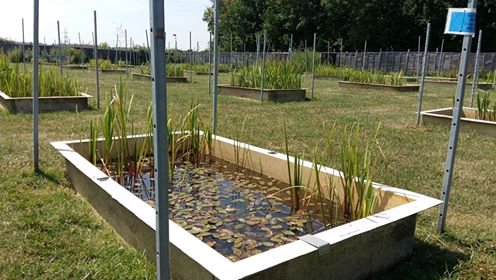My visit to the Cambridge Environmental Assessment
22/08/2018

Working hard setting up experiments, getting the expected results, and publishing your work in great journals are all key goals for a researcher; however, communicating your research outside academia is also a professionally valuable experience. On 6th July, I had the chance to present my work and learn more about the great work that they do at Cambridge Environmental Assessment (CEA).
Cambridge Environmental Assessment is located in the picturesque countryside location of Boxworth, Cambridge. The Ecotoxicology team and Adrian Terry (head of CEA) were very pleased to meet me and discuss my work. I was interested in understanding the implications of my research in the environmental sector, and to gain insight into the roles and responsibilities of different pathways outside academia.
During the last year of my PhD (part of REMEDIATE), I have been focused on linking bioavailability of complex chemical mixtures to toxicity changes, providing multiple lines of evidence to inform risk management decisions at contaminated sites. Therefore, I presented my work on an experimental set-up where contaminated soils, collected from former gas work sites were treated with amendments (biochar or compost) incubated for 6 months, and their toxicity evaluated thought different ecotoxicological assays. The CEA team was very engaged, asked a lot of questions and provided valuable feedback on my work.

Eco-toxicological assays earthworms acute toxicity test (Location: Cranfield University)
Throughout the day Dr. Adrian Terry presented/introduced the CEA team (which includes experts in environmental fate and behaviour, exposure and spatial modelling, ecotoxicology and toxicology), and explained the overall aim and objectives of the company.
Dr. Hanna Schuster, presented the current work on over 200 outdoor aquatic mesocosms (flat-bottomed or sloped) to simulate different edge-of-field environments with a focus on plants and invertebrates (e.g; in-house identification of freshwater phytoplankton, periphyton, macrophytes, zooplankton, and macroinvertebrates). Hanna also guided me through the facility to visit their mesocosms set-up for bespoke higher-tier aquatic studies.

Mesocosms setup for bespoke higher-tier aquatic studies (Location: CEA)
Dr. Nadine Taylor, presented a range of different works including the very interesting research projects she developed during her PhD and postdoc using molecular high throughput techniques and physiological endpoints to determine ecosystem changes to environmental stress.
I would like to express my sincere thanks to my sponsor for providing funding for my training and networking opportunities; and to the ecotoxicology team and Adrian Terry for hosting me at CEA and appreciating my research work.
It was a great day for me to network and discuss my work with experts in the field, and hopefully future collaborations will arise from this meeting.
If you would like to learn more please visit https://www.cranfield.ac.uk/research-projects/remediate
Links
Note: Top photo located within Cranfield University.
Categories & Tags:
Leave a comment on this post:
You might also like…
Preparing your work for Turnitin submission
Before submitting your work into Turnitin for similarity checking, if you have used referencing software then you may need to take some important steps first. Mendeley and Zotero integrate with MS Word by embedding field ...
The fast track to supercar engineering: My Cranfield journey
It’s been a dream come true to work on some of the world’s most prestigious supercars – the Aston Martin Valhalla, McLaren 750 & Artura, the GMA T.33. But every successful ...
Automotive Engineering: From student to hypercar innovation at Rimac
We sat down with recent graduate Thomas Perrin, to discuss how his year on the MSc in Automotive Engineering at Cranfield University propelled him from the lecture hall directly into the ...
What this year at Cranfield really meant to me
Every Cranfield journey is unique. In this alumni reflection, Zachea Scicluna shares what her year at Cranfield truly meant, from facing uncertainty to gaining hands-on experience in industry-backed projects. I’ve been reflecting (and delaying) ...
Preparing for assignments and exams?
Sorry! We know it seems a bit mean to mention the exams in January rather than looking forward to the break before it! However, we know many of you will be thinking about your forthcoming ...
Screening for FTSE 100 companies on Bloomberg
So you’re researching an index and need some data on its constituent companies? Bloomberg’s Equity Screening tool makes light work of this, not just for the FTSE, but for indices, exchanges and sectors worldwide. Type EQS ...






